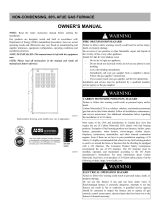
4
Keep air filters cleaned. Clean or replace filter to maintain
proper airflow and achieve maximum efficiency. Refer to
page 11 for Maintenance & Inspection information.
FLOOD DAMAGE
WARNING:
Do not use this furnace if any part has been under
water. A flood damaged furnace is extremely
dangerous. Attempts to use the furnace can result
in fire or explosion. A qualified service agency
should be contacted to inspect the furnace and
to replace all gas controls, control system parts,
electrical parts that have been wet or the furnace
if deemed necessary.
VENTING SYSTEM
WARNING:
It is imperative to maintain proper operation of the
venting system, including the masonry chimney
(if applicable). Insufficient venting could create
the production of excessive amounts of Carbon
Monoxide (CO) - a colorless, odorless gas that is
produced during incomplete combustion of any
fuel. It can cause death without warning. Carbon
monoxide poisoning can cause flu- like symptoms
and also dizziness, fatigue, headaches, nausea,
and irregular breathing.
If you suspect that you are experiencing CO
poisoning, get fresh air immediately. Leave the
home and call for assistance from a neighbor’s
home.
WARNING:
CARBON-MONOXIDE POISONING HAZARD
Failure to follow instructions could result in severe
personal injury or death due to carbon-monoxide
poisoning if combustion products infiltrate into the
building.
Check that all openings in the outside wall around
the vent (and air intake) pipe(s) are sealed to prevent
infiltration of combustion products into the building.
Check that furnace vent (and air intake) terminal(s) are
not obstructed in any way during all seasons.
• The U.S. Consumer Product Safety Commission (CPSC)
recommends every home have a Carbon Monoxide detector
in hallways near the bedrooms in each sleeping area. CO
detectors should be certified to the most recent requirements
of the UL, IAS OR CSA Standard and should be installed,
operated, and maintained in accordance with the detector
manufacturers instructions.
CLEARANCES TO COMBUSTIBLES
WARNING:
Do not place combustible materials on or against
the furnace cabinet or within 6 inches of the vent
pipe. Furnace area must be kept clear and free
of combustible materials, gasoline and other
flammable vapors and liquids. A fire or explosion
may result causing property damage, personal
injury or loss of life. Failure to follow the safety
warnings exactly could result in serious injury,
death or property damage.
The furnace is designed to have certain clearances to
combustible items such as wood, paper, etc. Some types
of insulation are combustible. If your furnace is installed in
an attic, near unfinished walls, or in other insulated space,
keep area surrounding the furnace free of insulating material.
FLAME ROLL-OUT LIMIT SWITCH
Verifies the inducer motor is drawing combustion gases
through the heat exchanger properly. The temperature
switch prevents furnace operation in the event of flue or
combustion air passageway blockage, or improper inducer
motor operation. If blower is running and control board is
showing Open Limit flash code, check the following:
1. Set the thermostat to OFF or lowest setting.
2. Turn OFF all electrical power to the furnace.
3. Allow the furnace to cool if recently operating.
4. Carefully reach in and re-set the roll-out limit switch located
on the gas burner head by depressing button on top of
limit. Note: If limit doesn’t re-set it may require more time
to cool.
5. Check flue passageway for any blockage and clean as
required.
6. Restore electrical power to the furnace.
7. Set thermostat to initiate a call for heat.
8. Monitor the furnace and inducer motor for any unusual
operation or noise. Allow the unit to operate for 15-20
minutes to ensure proper operation.
9. If flame roll-out limit trips consult a licensed HVAC
technician for service.
SOURCES OF CORROSION
It is known that certain common household chemicals can
cause heat exchanger corrosion if the vapors are pulled into
the furnace’s burners The following is a list of chemicals that
should not be used or stored near the furnace.
Do not store these chemicals near the furnace:
• Permanent wave solutions
• Chlorinated waxes and cleaners
• Chlorine based swimming pool chemicals
• Water softening chemicals
• De-icing salts or chemicals
• Carbon tetrachloride
• Halogen type refrigerants
• Cleaning solvents (perchloroethylene)
• Printing inks, paint removers, varnishes, etc.
• Hydrochloric acid
• Cements and glues
• Antistatic fabric softeners
• Masonry acid washing materials








